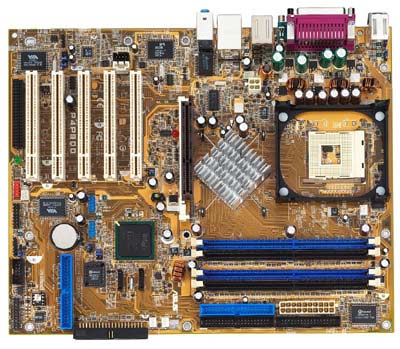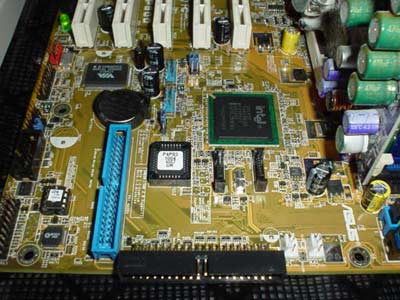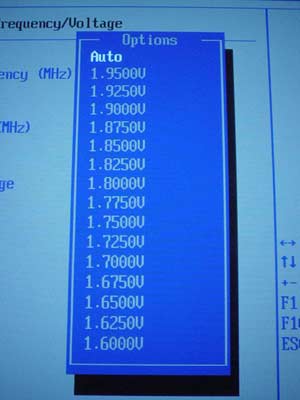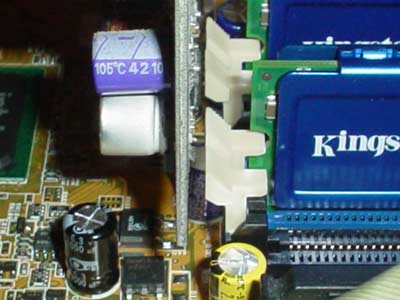865PE/875P Motherboard Roundup June 2003 - Part 1: 20-way Shootout
by Evan Lieb on June 12, 2003 10:57 PM EST- Posted in
- Motherboards
ASUS P4P800 Deluxe
|
Motherboard Specifications |
|
|
CPU
Interface
|
Socket-478
|
|
Chipset
|
Intel
82865PE MCH (North Bridge)
Intel 82801ER ICH5R (South Bridge) |
|
Bus
Speeds
|
up
to 400MHz (in 1MHz increments)
|
|
Core
Voltages Supported
|
up
to 1.950V (in 0.0125V increments up to 1.60V, and 0.0250V after that)
|
|
I/O
Voltages Supported
|
N/A
|
|
DRAM
Voltages Supported
|
up
to 2.85V (in 0.05V increments)
|
|
Memory Slots
|
4 184-pin
DDR DIMM Slots
|
|
Expansion Slots
|
1 AGP
8X Slot
5 PCI Slots |
|
Onboard IDE RAID
|
VIA
VT6410 controller
|
|
Onboard USB 2.0/IEEE-1394
|
Eight
USB 2.0 ports supported through South Bridge
VIA VT6307 IEEE-1394 FireWire (2 ports available) |
|
Onboard LAN
|
3COM
3C940 Gigabit LAN (no CSA)
|
|
Onboard Audio
|
Analog
Devices AD1985 codec
|
|
Onboard Serial ATA
|
Two
SATA connectors via ICH5R (RAID 0 & RAID 1 only)
|
|
BIOS
Revision
|
Rev.
1007
|

Though the P4P800 Deluxe is not as feature-rich as the high-end 865PE and 875P motherboards there are still lots of positive things to say about its features, especially for the price it's going for online.

First and foremost is the IDE RAID controller onboard the P4P800 Deluxe. VIA is certainly not known for their IDE RAID solutions, and so the VT6410 RAID controller is quite unique, in fact the first of its kind that we've ever come across. In combination with the Primary and Secondary IDE connectors (which support a total of four drives), the two VT6410-controlled IDE RAID connectors, and the two ICH5R-powered Serial ATA connectors, the P4P800 Deluxe is capable of supporting a total of 10 drives. That's an excellent amount of drive support for the middle-range asking price of the P4P800 Deluxe in the U.S.

Not surprisingly the P4P800 Deluxe contains excellent BIOS options, exactly the kind you would expect from ASUS. Some notable performance tweaking options include FSB adjustments available up to 400MHz, VDIMM adjustable up to 2.85V, AGP/PCI adjustments up to 80MHz/40MHz (about as high as is doable) and Vcore values available up to 1.950V in fine 0.0125V and 0.0250V increments. The FSB ceiling of 400MHz isn't in the least surprising as ASUS has always left lots of room for FSB overclockers in the past. What really stands out is the tremendous Vcore support available up to 1.950V. This ceiling is even higher when you take into account the average overvolt of 0.040V, meaning you could reach as high as 2.00V with your P4 processor on the P4P800 Deluxe (something we highly recommend against). Don't be alarmed though, ASUS has a history of producing motherboards that naturally overvolt. We should note that our FSB overclocking results were performed at a Vcore of just over 1.565V instead of the usual 1.525V because of the P4P800 Deluxe's default overvolting.
Quite obviously the most notable aspect of the P4P800 Deluxe is its ability to mimic PAT (Performance Acceleration Technology) found only on Intel's 875P series of chipsets. While the 865PE chipsets ASUS uses for the P4P800 Deluxe are not truly PAT enabled, ASUS has found a way to "crack" PAT microcode, enabling their P4P800 Deluxe motherboards to perform just as well as 875P motherboards for a significantly lower price. If you have a P4P800 Deluxe and want to make sure you're reaping 875P-like performance, make sure you enable MAM (Memory Acceleration Mode) and set the Performance Mode option to "Turbo" in the BIOS. We recommend that you use BIOS revision 1007 or higher (when available) for the best possible performance and reliability.

There are a few negative things we have to say about the P4P800 Deluxe. Firstly, we would have preferred it if ASUS had left some space between the AGP slot and DIMM connectors, as it's exceedingly inconvenient for users to have to uninstall their video card if they simply want to add or remove their memory modules. This feature is easy to implement, especially since there is an unusually large amount of space between the AGP slot and the first PCI slot.










18 Comments
View All Comments
Anonymous User - Thursday, July 24, 2003 - link
Could anyone clarify if the information for the sound system on the Abit IS7 is correct? The article lists it as being an Analog Devices AD1985. I thought it was Realtek?Thanks,
Harry
Anonymous User - Wednesday, July 23, 2003 - link
What a great article!We're waiting for the Part 2... :B
Evan Lieb - Monday, July 21, 2003 - link
I bet that the Part 1 thread would be posted by a certain date, and it was indeed posted on that date. I never anything about Part 2, because I've been thinking of adding more benchmarks and data in general to round out any and all Pentium 4 motherboard testing until Prescott arrives.Anonymous User #4, you should always research your recollections if you can't exactly "recall" certain events correctly. ;)
Evan Lieb - Monday, July 21, 2003 - link
Anonymous User - Friday, July 18, 2003 - link
As I recall, Evan made a bet on the part 2 being posted a while back.... the thread was mysteriously removed though.Anonymous User - Wednesday, July 16, 2003 - link
So, what month/year will part 2 be posted?Anonymous User - Sunday, July 6, 2003 - link
I read that the Epox 4pca3+ could do a 1,85 vcore with a bois update.. If anyone know where to find this bios update, please e-mail me zimen1@msn.comI really can't find it.
Anonymous User - Sunday, July 6, 2003 - link
I also fried my MSI 875P Neo-FIS2R when I updated the BIOS from 1.2 to 1.4. I got a replacement board, but have been hesitant to try again based on my prior experience. Based on your experience with 1.5, (and now 1.6 is available), I'm willing to take another chance.